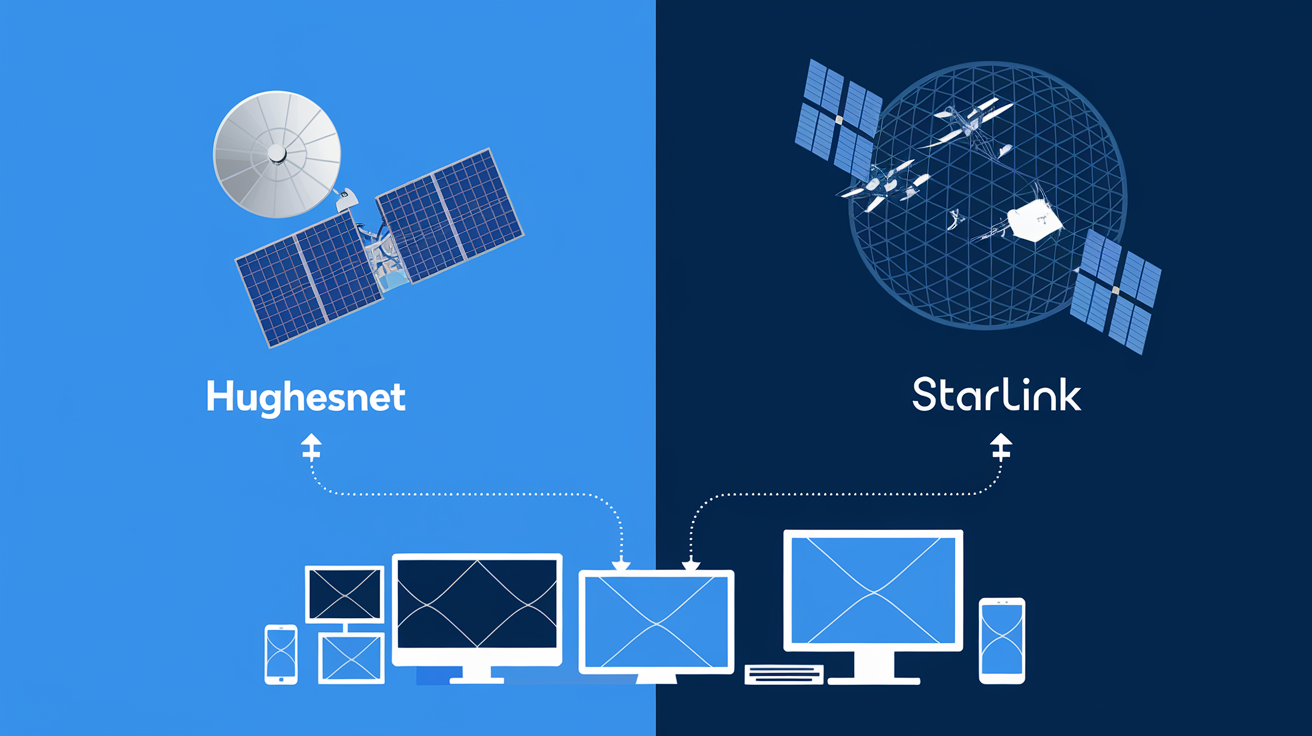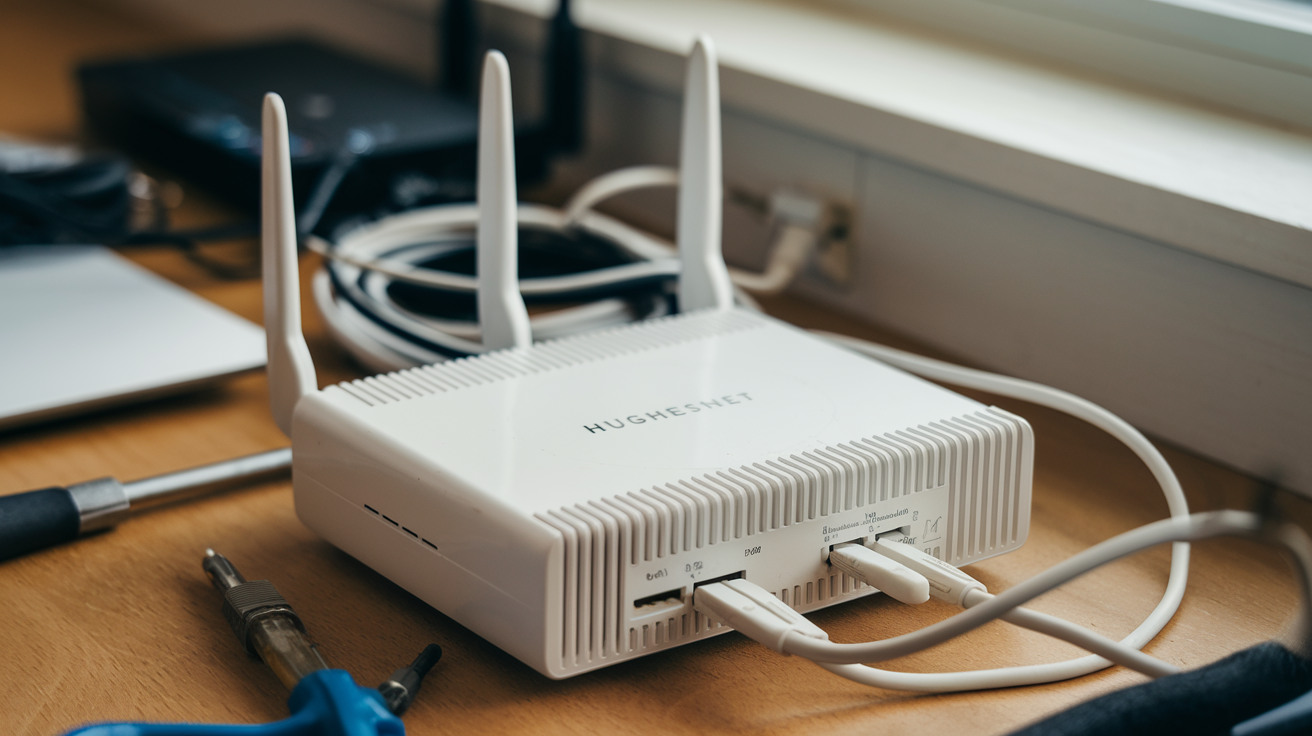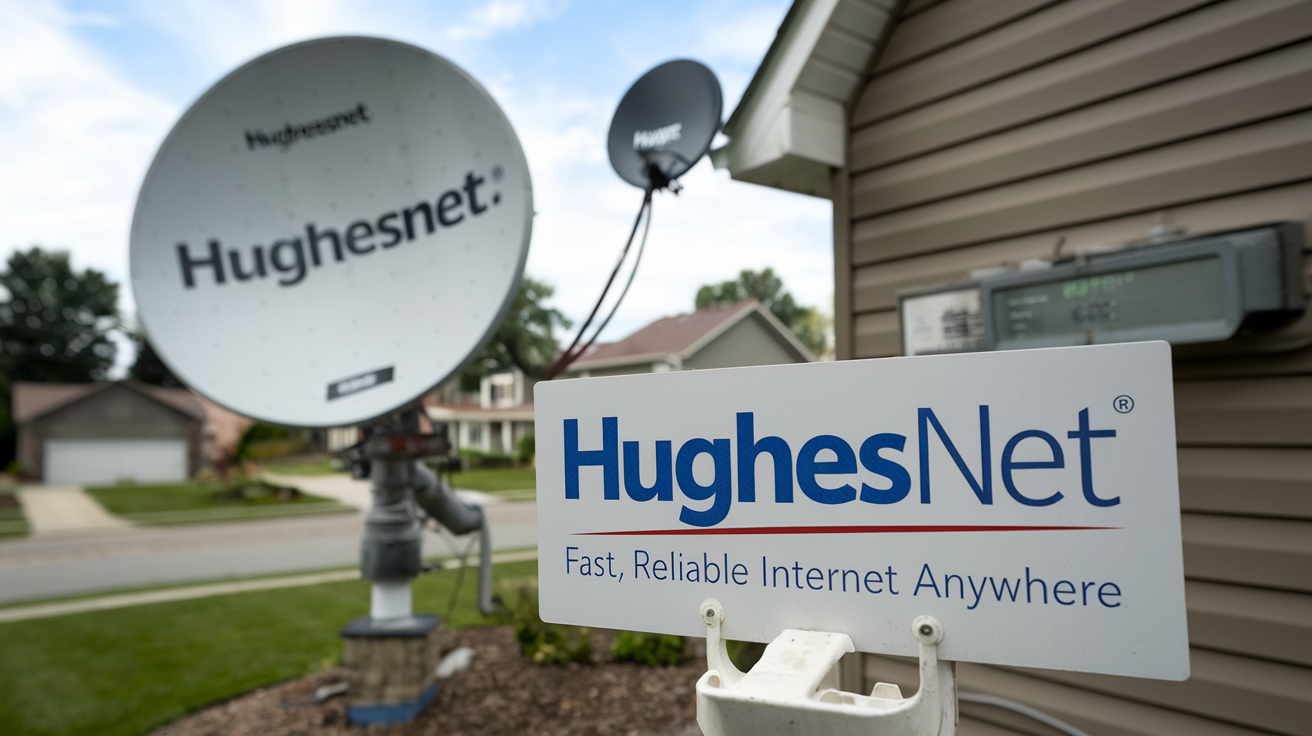-
Posted on: 24 Dec 2024

-
For people who need dependable home internet, especially in places with few choices, satellite internet is a popular option. Picking the right internet service provider is important for a good online experience. This blog post compares HughesNet and Starlink, two key names in satellite internet. We will look at their technology, performance, prices, and other details to help you find the best service for your needs.
Understanding Satellite Internet Technology
Satellite internet has changed how we connect to the internet. This is especially important in places where regular cable and fibre optic services don't reach. So, how does it work? Satellite internet sends signals from satellites moving around the earth to a dish at your home or office.
This technology breaks through distance barriers, giving internet access to even the most distant areas of the world. Now, let's look at how satellite internet works in more detail.
The Basics of How Satellite Internet Works
Imagine this: you want to visit a website on your computer. Your request goes from your device to your satellite dish. Then, it travels up to a satellite that is in orbit around Earth. This satellite works like a relay. It sends your request to a ground station called a network operations centre (NOC).
The NOC finds the information you need and sends it back to the satellite. The satellite then sends that data back to your dish and, finally, to your device. Just like that, you're browsing the internet! This whole process happens quickly, but it can be a bit slower than regular cable internet.
The speed and quality of your satellite internet connection depend on how high the satellite is in orbit. HughesNet uses geosynchronous orbit satellites that are about 22,000 miles above Earth. On the other hand, Starlink uses low Earth orbit satellites, which are much closer at about 340 miles. This difference in orbit affects latency, which is the delay in sending data, between the two providers.
Key Differences in Technology Between HughesNet and Starlink
HughesNet is a long-standing player in satellite internet. They use a few high-orbit satellites to cover a large area. This means they provide broad coverage but also have high latency. You can think of their satellites as strong but far-off lights. Signals have to travel longer distances, which causes delays.
Starlink, however, has changed the game. Instead of just a few far-away satellites, Starlink has a big satellite constellation in low Earth orbit. There are more satellites closer to the Earth. This setup allows for faster data transmission and lower latency.
In short, Starlink's closer satellites offer a quicker and better internet experience when compared to HughesNet. This is especially important for things like online gaming or video calls, where low latency matters a lot.
Comprehensive Comparison: HughesNet vs Starlink
Now that you understand the basic technology of HughesNet and Starlink, let's compare these two satellite internet providers. Both of them are good choices for connecting online, but they have important differences. These differences include how well they perform, their prices, and how users feel about their overall experience.
Knowing these details is important for finding the best satellite internet service that fits your needs and budget.
Speed and Performance: A Side-by-Side Look
When choosing an internet service provider, speed is often a top consideration. Let's compare the download and upload speeds offered by HughesNet and Starlink.
As the table illustrates, Starlink generally boasts faster speeds compared to HughesNet. This difference is particularly noticeable in the download speed range. However, it's essential to remember that actual speeds can fluctuate based on factors like location, network congestion, and weather.
Both providers have made significant strides in enhancing speed and reliability, but the technological difference in their satellite orbits gives Starlink a distinct advantage in delivering faster speeds.
Pricing Plans: Evaluating Costs and Value
When picking an internet plan, the cost is very important, along with speed. HughesNet has plans that cost between $74.99 and $119.99 each month. These plans give different data limits, making them a good choice for people on a budget. However, HughesNet does need you to commit to a two-year contract.
Starlink offers a different option. Its prices are a bit higher. The basic plan starts at $120 each month and offers unlimited data. But you also have to pay $599 upfront for the Starlink kit, which comes with a dish and router. Even though Starlink costs more to start, it provides value with faster speeds, unlimited data, and no contracts.
In the end, picking between HughesNet and Starlink plans depends on what you need and your budget. If you are worried about upfront costs and want something cheaper, HughesNet is a good option. But if you want faster speeds, unlimited data, and no contract hassle, Starlink could be the better choice for you.
Data Caps: Limitations and Flexibility
Understanding data caps is important when picking an internet plan. If you go over these limits, you may face slower speeds or extra charges. HughesNet has plans with different data caps. This can be a problem for people who use the internet a lot. When you exceed your data limit, your internet speed will drop a lot.
On the other hand, Starlink offers unlimited data with all its plans. But keep in mind that while Starlink provides unlimited data, the internet speed can change during busy times because of network congestion. Even with these speed changes, having unlimited data is a big plus for those who need the internet for streaming, gaming, or working from home.
In summary, if data usage is very important to you, Starlink's unlimited data plan is a great choice, even with possible speed issues. If you don’t use the internet much, HughesNet's plans with data caps might give you enough data for a lower price.
Equipment and Installation: Setup Costs and Requirements
Both HughesNet and Starlink require special equipment for their satellite internet services. HughesNet gives you a satellite dish and modem, and it usually includes professional installation in their plans.
Starlink works a bit differently. Customers need to buy the Starlink kit, which comes with a satellite dish and a Wi-Fi router, for an upfront cost. However, Starlink allows you to install the setup yourself. The Starlink dish is made for easy setup, and the app gives clear instructions, making it simple to use.
In short, HughesNet makes things easy by providing both the equipment and installation in their plans. On the other hand, Starlink lets you control the installation process, but you need to pay upfront for the equipment. Your choice depends on how much you value convenience compared to control and what fits your budget.
Geographic Availability and Coverage
Satellite internet is strong because it can connect people in remote and underserved areas. HughesNet and Starlink are both good at offering services that regular internet can't reach, but they cover different areas.
Let's look at where each provider operates. This will help us understand how they connect users around the world.
HughesNet’s Reach in Rural and Remote Areas
HughesNet has made a strong impact in rural and remote areas of the United States. Its wide satellite coverage has made HughesNet a critical source of internet for communities without cable or fiber optic service.
The company is dedicated to helping these areas, making HughesNet a trustworthy choice for people and businesses in off-the-beaten-path locations looking for stable internet, even if it is slower. For many years, HughesNet was the most popular satellite internet service, reaching even the toughest spots.
This broad coverage shows how much HughesNet cares about closing the digital gap and giving individuals in rural areas the chance to access information and opportunities.
Starlink’s Expansion and Global Coverage Efforts
Starlink aims to provide internet coverage to the entire world. Since its first beta launch, it has quickly grown its reach. Unlike typical satellite providers that have limited coverage, Starlink uses a group of satellites in low Earth orbit. This helps them offer internet access to many more people.
With this setup, Starlink can send internet services to areas that usually have poor connectivity. As they add more satellites, their global coverage map keeps growing, reaching remote places and people who need high-speed internet access.
This growth is set to change how we connect to the internet. It will open up new chances for education, economic growth, and global communication.
Impact of Weather on Service Reliability
Weather is a factor we can't control, and it can affect how reliable satellite internet is. Satellite internet, like HughesNet and Starlink, has improved to deal with issues caused by weather. However, it's important to know how weather can impact their performance.
Let’s look at how each provider handles different weather conditions to understand how well they perform.
HughesNet’s Weather Resilience
As a satellite internet service, HughesNet can be affected by bad weather like heavy rain, snow, or thick clouds. These weather conditions can block the signal between the satellite and your dish. This may result in slower speeds, higher latency, or even short service outages.
HughesNet understands that severe weather can affect service quality. They want you to know that their network is built to handle normal weather, but extreme conditions can temporarily reduce performance.
While HughesNet works hard to provide reliable service, users living in areas with harsh weather should think about possible disruptions. It's good to plan your internet usage based on the weather in your area.
Starlink and Weather-related Disruptions
Starlink is known for its low latency and high speeds. However, it can still be affected by the weather. The user terminal needs a clear view of the sky to work well.
Things like heavy snowfall or thick trees can block the signal. This can result in slower speeds or interruptions in connection. Still, Starlink has an advantage. It uses low Earth orbit satellites that are closer to the ground than HughesNet satellites.
This closer distance helps to make the signal stronger. It can also lessen the effects of weather problems, but it does not completely remove them.
User Experience and Customer Satisfaction
When picking between HughesNet and Starlink, looking at user experience and customer satisfaction is very important. Customer service, user reviews, and feedback from the community can help us understand how well these services perform and how reliable they are.
Let's look at how customer service compares and read user reviews and stories to see how satisfied people are with HughesNet and Starlink.
Customer Service Comparisons
Customer service is essential for fixing technical problems, answering billing questions, and making sure users have a good experience. HughesNet has special customer support options. You can reach them by phone, email, or online chat for help with your questions and worries.
Starlink takes a different route. They use a more self-service style for customer support. Their website has helpful guides, frequently asked questions, and community forums. Users can find support from other Starlink customers there.
Choosing between HughesNet's direct customer support and Starlink's self-service option depends on what you prefer. Some people might like HughesNet's dedicated help, while others might prefer the easy resources and community help that Starlink provides.
User Reviews and Testimonials
User reviews give a good look into the real experiences of people using HughesNet and Starlink. HughesNet has been around longer and has mixed reviews. Many users like its wide availability and steady service. Still, some are worried about slower speeds and data caps.
Starlink is newer and gets mostly positive feedback. Users of Starlink often mention its much faster speeds, unlimited data, and lower latency compared to regular satellite internet.
Keep in mind that user experiences can vary depending on what you need, where you live, and how the network works. When you read user reviews, focus on those from people in your area for the best information.
Future Developments and Innovations
HughesNet and Starlink are always putting money into research and development. They want to improve their services and provide a better satellite internet experience. Their promise to innovate brings hope for some great changes soon. This will help bring people closer to the internet and change the way we connect online.
Let’s explore the new features and improvements coming from HughesNet and Starlink.
Upcoming Enhancements in Starlink’s Service
Driven by Elon Musk's goal to change internet access, Starlink is always working on new ideas and growing its satellite internet service. A major focus is to increase network capacity. This means faster speeds and better reliability for users.
Starlink plans to send out thousands more satellites into lower Earth orbit. This will make their network denser and improve capacity for an increasing number of users. They are also improving their ground station support to help signals flow smoothly and provide better quality service overall.
These updates help Starlink stay on top in the satellite internet world. As they move forward with new technology, Starlink users can look forward to a faster and more reliable internet experience.
HughesNet’s Plans for Improving Connectivity
Recognizing the need for high speeds in today's digital world, HughesNet is working hard to improve its satellite internet service. One example of this effort is HughesNet Fusion. This is a hybrid internet service that uses both satellite and ground-based connections to give you a faster and more reliable connection.
HughesNet Fusion takes advantage of both satellite and wireless networks. By bringing these two together, HughesNet can reduce delays and boost internet speed. This is especially helpful for online gaming and video calls.
With these ongoing efforts to improve its network and create new solutions, HughesNet wants to reach more customers, especially in areas that lack good service, providing a better satellite internet experience.
Conclusion
When choosing between HughesNet and Starlink for your internet service, think about a few things. Consider the speed, pricing, data caps, and how reliable the service is during bad weather. HughesNet is great for rural areas, and Starlink is working to grow its services worldwide. Good customer service and user satisfaction are very important when picking the right provider. Keep yourself updated on new features from both companies. This will help you make a good choice based on your needs. If you want more help finding the best internet service, contact our experts for advice today.





